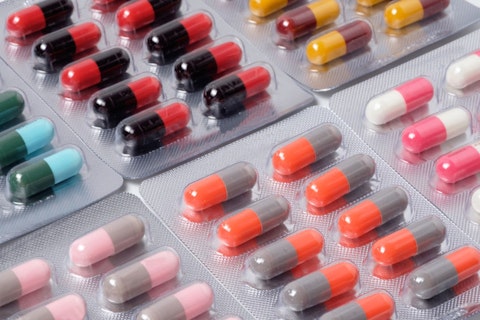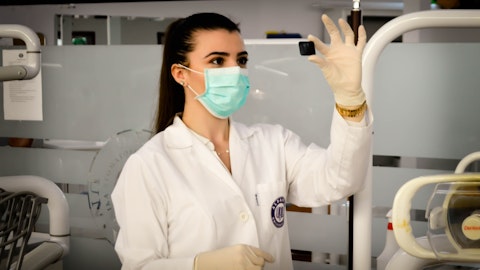Viatris Inc. (NASDAQ:VTRS) Q2 2023 Earnings Call Transcript August 7, 2023
Viatris Inc. misses on earnings expectations. Reported EPS is $0.2194 EPS, expectations were $0.71.
Operator: Good morning. My name is Todd, and I will be your conference operator today. At this time, I would like to welcome everyone to the Viatris 2023 Second Quarter Earnings Call and Webcast. All participant lines have been muted to prevent any background noise. After the speakers’ remarks, there’ll be a question-and-answer period. [Operator Instructions] Thank you. I will now turn the call over to Bill Szablewski, Head of Global Capital Markets. Please go ahead.
William Szablewski: Good morning, everyone. It is my pleasure to welcome you to our second-quarter 2023 earnings call. With us today is our CEO, Scott Smith; President, Rajiv Malik; CFO, Sanjeev Narula; and Jeff Nau from our Eye Care division. During today’s call, we will be making forward-looking statements on a number of matters, including our financial guidance for 2023, and various strategic initiatives. These forward-looking statements are subject to risks and uncertainties that could cause future results or events to differ materially from today’s projections. Please refer to today’s slide presentation and our SEC filings for a full explanation of those risks and uncertainties and the limits applicable to forward-looking statements.
We will be referring to certain actual and projected non-GAAP financial measures to supplement investors’ understanding and assessment of our financial performance. Reconciliations of those non-GAAP measures to the most directly comparable GAAP measures are available on our website and in the appendix of today’s slide presentation. An archived copy of today’s presentation and other earnings materials will be available on our website at investor.viatris.com following the conclusion of today’s call. With that, I will now hand the call over to our CEO, Scott Smith.
Scott Smith: Good morning to everyone on the call. I’m pleased to report that the second quarter of 2023 was one of the strongest quarters we’ve had to date at Viatris. I could not be more pleased with our overall execution. The positive momentum of the base business continues to push us forward. We are laser-focused on delivering our pipeline and are excited about new product launches. In the second quarter, we delivered total revenues of $3.9 billion, representing approximately 2% year-over-year growth on an operational adjusted basis and adjusted EBITDA of $1.3 billion and free cash flow of $447 million, both of which were ahead of our expectations. Based on our performance this quarter and in the first half of the year, we are reaffirming our full-year financial guidance for 2023.
These results signal the beginning of what we expect to be a growth journey for Viatris and set us up well for future success as we prepare to bring Phase 1 of our strategic plan to successful completion and initiate Phase 2, beginning in 2024. While I’m proud of our strong performance, the foundation the company has built and the stability and predictability that we believe have clearly been achieved. My focus is on the future and on the trajectory of the company moving forward. Now let’s turn our attention there. On executing our planned divestitures, we are on track to announce all transactions in 2023. As we said, executing these planned divestitures is a matter of strategic choice, not a necessity. I am extremely pleased with where we are in the process.
We are currently in advanced stages of discussions with potential buyers and anticipate announcing at least one significant divestiture in the third quarter, possibly more. As a result, I will not be in a position to take any further questions on this topic during Q&A today, but very much look forward to discussing it in detail with you at an appropriate time in the future. The company has laid out a clear capital allocation of business development priorities for Phase 2, and we are fully dedicated to executing on these priorities, which will allow us to continue our move up the value chain. We intend to earmark approximately 50% of our free cash flow annually to be returned to shareholders in the form of dividends and especially share repurchases.
With the remaining capital, we intend to invest in our businesses, both organically and inorganically. I continue to be focused on looking for strategically significant transactions in ophthalmology, gastroenterology, and dermatology, as well as evaluating other therapeutic areas should the right opportunities arise. It’s become apparent to me that there are many assets that could fit our needs and are transactable. I am optimistic about our ability to execute high-quality business development deals, not only through M&A but also through strategic licensing agreements and partnerships when the time is right. In summary, I am very proud of our execution to date, the health of the company, and the strong foundation that has been built. Looking ahead, I believe in the future trajectory of the company and I’m very excited for what’s to come.
I will now turn the call over to Rajiv to provide you with an update on our operations and our pipeline and then to Sanjeev who will give you more details of our financial results, 2023 guidance, and capital allocation activities. Rajiv?
Rajiv Malik: Thanks, Scott, and good morning, everyone. Our strong performance this quarter highlights the momentum of our business like never before and further reinforces the predictability of our base business, which is well-diversified from a geography, as well as portfolio point-of-view. The performance of the last 10 quarters demonstrates that our business model of bringing access has never relied on any one product or any one market. That strength of our underlying business is enabling us to position the company well for Phase 2 growth. Our continued new product revenue performance is another key feature of our plan and for this year, again, we remain on track to deliver on our expectation of approximately $500 million of new product revenue.
As I provide the commercial segment highlights for the quarter, I will be making certain comparisons on an operational basis, which excludes the negative impact of foreign currency rates versus the plan that supports our financial guidance. In addition, I will be making certain comparisons to our Q2 2022 results on a divestiture-adjusted operational basis as defined in our earnings lease. This quarter total net sales grew 1.5% on an operational basis due to a strong performance across various geographies and product portfolios. We believe achieving this top-line growth for the first time as Viatris to flex the power of our platform, well-thought-out strategy, and our consistent execution. Let me get into our commercial segment highlights. Our well-balanced business of developed markets where brands makeup approximately 55% of our net sales in quarter two delivered another strong quarter.
Europe performed ahead of our expectations, delivering 2% year-over-year growth on an operational basis. Italy, Spain, and UK, as well as several other markets, drove the strong momentum for the quarter. As solid performance of generics in Europe was another contributing factor. Our North America business was flat year-over-year on an operational basis and also performed ahead of expectations. Generics delivered a better than expected performance, led by lenalidomide, Wixela, and Xulane. Our brand business was supported by strong demand in epinephrine market, and Yupelri, which grew 12% this year over the last year. Yupelri, which is the only nebulized long-acting muscarinic agent available in the market continues to show significant growth and enjoys about a 30% market share in the broader long-acting nebulized COPD market, and is well on its way to become the number-one product in this space.
Our new launches in North America are on track, and we are very excited about our recent introduction of Breyna, our generic Symbicort. We expect that this launch will be 180 days first-to-file generic exclusivity which is subject to FDA’s future determination of the issue, if and when another ANDA filer becomes eligible for final approval. For the second half of the year, we believe the developed market segment is poised for year-over-year growth and we remain confident to meet or exceed our full-year expectations of both North America and Europe. Emerging markets had another strong quarter and delivered 10% year-over-year operational growth, led by the stronger than expected performance of genetics and brands like Lipitor, Lyrica, and Celebrex.
Emerging Asia and Middle East were strong-performing geographies. We remain confident for this segment to deliver better than expected for the full year and grow versus the prior year. JANZ performed in line with our expectations and we anticipate continuing to meet our expectations for the full year. In Greater China, we delivered 1% operational growth in this quarter, primarily due to Viagra and other retail-driven products in China. We remain on track to meet our planned expectations for the year. Our team in China has been focused on continuing to expand our presence in the private channel while navigating and managing the evolving policy dynamics on the ground. We have also been very focused on building and expanding our pipeline of new products in China.

Copyright: zneb076 / 123RF Stock Photo
To that end, our NDAs for Dymista and for Formed received approval from SFDA in this quarter. In addition to this, our partner’s NDA for Tyrvaya was also accepted, while eight other products are under active review. Moving to Eye Care. Tyrvaya’s launched continued to progress as planned in its second quarter as part of Viatris. During the quarter, Tyrvaya’s bridge program was optimized to drive increased value per script and achieved the highest quarterly TRX launched to date. Furthermore, we remain focused on maximizing its potential, including increasing share of Medicare prescriptions, driving continued growth in total prescriptions, and launching the brand’s first direct-to-consumer campaign in the fourth quarter, which together, we believe provides support for our near and longer-term expectations for the brand.
We are also excited by the continued progress of our eye care pipeline, which is aimed at addressing a range of vision-related disorders. Our NDA review of MR-140 for the reversal of mydriasis program is under active review with a PDUFA date of September 28 of this year. We have completed patient enrollment in the first pivotal Phase 3 trial of MR-141 for the treatment of presbyopia and expect top-line data in Q3 of this year. And we remain on track to initiate the second Phase 3 trial later this year. We have initiated patient enrollment in the first Phase 3 study, MR-148 for the treatment of Dry Eye Disease and expect top-line data in 2024. We are initiating a Phase 3 program of MR-139 for the treatment of blepharitis later this year. MR-142 for Night Vision Disturbances and MR-146 for Neurotrophic Keratopathy also remain on track.
Switching to other pipeline updates, and beginning with the news we announced today around GA Depot. The FDA has accepted for review our recently submitted NDA and assigned a PDUFA date of March 8, 2024. Our application is backed by Phase 3 efficacy and safety data, and we believe GA Depot could improve patient experience through fewer injections, greater tolerability, and increased compliance. We are feeling very confident in the strength of our GA Depot clinical program and continue to believe that we remain on track to launch in the second half of 2024. We are equally excited about the potential opportunity to also bring this for our — to patients in Europe, which we expect to file later this year. Our Botox biosimilar program is progressing well from the development, characterization, as well as validation of drug substance and drug product perspective.
We remain on track to file our IND by the end of this year. Our Phase 3 study forward Xulane Low Dose program in the USA remains on track with nearly 800 of the planned 12,000 women enrolled. We are targeting completion of enrollment by March 2024. And our Phase 3 study for Effexor Generalized Anxiety Disorder in Japan is well on-schedule, and we are targeting an NDA filing in the first half of 2025. Lastly, all our complex injectable programs are moving ahead as planned. Before I turn the call to Sanjeev, I want to thank our colleagues for another strong quarter and consistent performance. With that, Sanjeev?
Sanjeev Narula: Thank you, Rajiv, and good morning, everyone. We had another excellent quarter and are seeing the results of our efforts, which include revenue growth versus the prior year. Unless otherwise stated, I will be making year-on-year comparison on a divestiture-adjusted operational basis as defined in our earnings release. The second quarter exceeded our expectations. We are encouraged by our fundamentals and continued strong operational performance. Our branded business and new product revenue was contributing to a favorable gross margin. In the quarter versus the prior year, net sales from emerging markets, Europe, and Greater China grew. The revenue growth included the impact of the new product and we expect this momentum will continue with our recent Breyna launch.
We continue to invest behind future growth drivers which includes the Eye Care Division’s commercial investment and late-stage pipeline programs. We believe that our unique global platform, which is diversified across product categories has proven its ability to continue to generate significant and sustainable free cash flow. And we remain confident in the durability of this performance moving forward. Turning to Q2 and first-half 2023 highlights. To summarize results versus the prior year on a reported basis, including the biosimilar business in 2022. Net sales were slightly ahead of expectations and grew at 1.5% versus the prior year. This performance is consistent with our expectations for the business over the long term. On a reported basis, foreign exchange had an impact of approximately 2% of net sales versus the second-quarter 2022.
The diverse portfolio of growth drivers included brand performance in the emerging market, Europe and Greater China. We expect this M&A trends to continue in the second half, aided by product seasonality and the continued ramp of new products. New product revenue in the quarter met expectations and included sales of all strengths of lenalidomide. Adjusted gross margin of approximately 60% in the quarter exceeded our expectations, and was driven by a positive portfolio mix and lower than expected inflation on COGS. We reported strong adjusted EBITDA, which included the anticipated step-up in SG&A associated with the Eye Care division and the R&D to advance key programs across Eye Care, injectable and complex products. We had another solid quarter of free cash flow of $447 million, ahead of our expectation.
The year-on-year decline was primarily driven by lower adjusted EBITDA due to the biosimilar divestiture, the impact of foreign exchange, and anticipated timing of working capital. We are delivering on our capital allocation priority and continue to pay down debt to reach our gross leverage target of 3 times. We remain in a strong balance sheet position and are committed to our investment-grade rating. In the quarter, we paid down shortened debt of $181 million for a total of approximately $6.1 billion since the beginning of 2021. We expect to pay down the $500 million maturity in Q4 from cash on hand. Additionally, we returned approximately $144 million of capital to our shareholders in the quarter through the dividend. The strong performance in the first of this year gives us continued confidence in our Phase 2 outlooks.
Although, we’re not providing guidance beyond 2023, it remains our expectation to generate at least $2.3 billion of free cash flow from the rebased business before any associated transaction costs and taxes. We are reaffirming our 2023 financial guidance ranges and expect full-year revenue, adjusted EBITDA, and free cash flow to be at the midpoint of the ranges. We are closely watching foreign exchange of select currencies. While we have absorbed the impact of foreign-exchange headwinds in the first half versus what we had assumed in our February guidance, it is possible that we may encounter a slight headwind in the second half. Now, a few updates on the expected phasing for the rest of the year. We continue to expect total revenue to be higher in the second half due to the launch and ramp of new products, as well as normal product seasonality, particularly in developed markets.
We expect adjusted EBITDA to be slightly lower in the second half driven by two factors. First, gross margin moderating due to a less favorable portfolio and segment mix, as well as expected higher COGS driven by inflation. And second, the investment we’re making behind future growth drivers, this includes DTC investment in Tyrvaya, Eye Care pipeline, and organic R&D. We anticipate free cash flow to be slightly lower in the second half based on our adjusted EBITDA outlook, an increase in capital expenditure and one-time costs. As a reminder, our free cash flow guidance does not include any transaction costs and taxes associated with the biosimilar divestments, the Eye Care acquisition, or the planned divestiture. Additionally, our adjusted EBITDA and free cash flow ranges exclude any required IPR&D for unsigned deals.
In the second quarter, we incurred $10 million of IPR&D related to our investments in Japan. In closing, based on the continued strong underlying fundamentals of the business, we’re well-positioned for the remainder of the year and look forward to 2024 and beyond. With that, I’d like to hand it back to the operator to begin taking your questions. Thank you.
See also 15 Best Penny Stocks To Buy Now and 25 Best States to Retire in for Taxes and Cost of Living.
Q&A Session
Follow Viatris Inc
Follow Viatris Inc
Operator: Thanks you. [Operator Instructions] We’ll take our first question from Glenn Santangelo with Jefferies. Please go ahead.
Glenn Santangelo: Yes. Thanks and good morning. Hey, Scott, just a couple of quick questions for you. I appreciate that you don’t want to talk about the divestitures, but maybe you could just answer one high-level question. You’ve been in your seat now for just over four months. And I’m kind of curious, from your perspective is it fair to say that you’re happy with how the process has been run, and you’re happy with the demand you saw in the process because it’s obvious that you weren’t in your seat when this process started and you kind of inherited and I appreciate we’re far along seeing, you don’t want to give any comments, but I was wondering if you could just comment at a high-level if you’re happy with where you’re at in the demand you’re seeing.
Scott Smith: Thank you very much, Glenn, for the question. Yes. I would say, I’m very happy with what I’ve seen. These are very well-performing businesses. There’s been lots of demand, there’s been lots of interest in these assets. We’re very excited on where we are in the process. I would say that we’re in discussions with multiple potential buyers on multiple assets and we’re looking forward to giving people the details on the time and the place where we can. Just one other comment that I think is really important and it’s important to remember that these divestitures represent a [cash flow] (ph) that will be coming to us to help us accelerate towards our desired leverage ratios. What they do is, they really set us up well going into 2024 and beyond.
And the critical thing for the future is our ability to deliver on our capital allocation plans in 2024 and beyond, which include capital return to investors through divestitures and particularly share buybacks and also business development and M&A, licensing, and partnership. So, very happy with the process and very happy to be accelerating into 2024 and beyond.
Operator: Thank you. We’ll take our next question from Jason Gerberry with Bank of America.
Jason Gerberry: Hey guys, thank you for taking my question. Curious, are there any alternative structures that you guys would consider with these divestitures to minimize the tax consequences? And then with Tyrvaya, just wondering, what’s going to drive a growth inflection here, do you really think that the DTC could be needle-moving for this product?
Scott Smith: So, first of all, thank you, Jason, for the question. I can’t comment on the deal structures or anything like that at this point in time. I would just be all speculation. I will turn it over though to — for the Eye Care question, please.
Jeff Nau: Yes. Hi, this is Jeff Nau. Yes. And I think it’s a great question. We look at the marketplace for dry eye disease there’s about 2 million patients currently being treated, but about 16 million that have been diagnosed. So, I think, among other things that we talked about on the prepared remarks, including an increase in Medicare, and many of the other tactics that we’re taking into account, that 14 million patients that are sort of sitting on the couch, waiting for a new therapy, it’s not something that’s really unlocked to us today. And that’s really I think the benefit that the DTC campaign brings forward.
Jason Gerberry: Thanks, Jeff.
Operator: We’ll take our next question from Ash Verma with UBS.
Ash Verma: Hi, good morning. Thanks for taking my question. So for the EU OTC business, not asking about the spin-off, but just wanted to understand any business trends that you can highlight. Some of the other like OTC players in Europe had particularly strong start to the year, but now flagging more of a normalization of that growth trend. So anything that you can share in that? And then just on complex injectables, I wanted to get a sense around the timing of some of the key launches of these products. I think you’re estimating $1 billion in peak sales by 2027. So just wanted to understand if you have confidence in the approval timelines here? Thanks.




